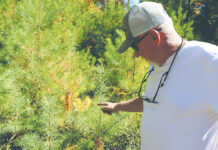Funny how time flies! It feels like we say this every month, sometimes even weekly. It’s only October and snow has already hit the ground; things might already be looking messy.
If you are always playing catch-up, time flies and things tend to get harder. Maybe you have some stockpiled fields and feel pretty good coming into winter. In a stockpiled situation, 10 inches of mixed fescue will roughly get you about 3,000 pounds of dry matter per acre. When the frost hits, grasses can start stalling and calculations need to be made.
Stockpiled fields
If cattle eat roughly 3% of their weight, that can translate to 1,000 pounds of feed monthly. All of a sudden, the fields look smaller. It is not the worst thing to be in a tight spot if time is on your side. You have options, take in account the number of paddocks and cows that you own.
Round numbers are much easier to handle. In a 10-inch field of grass, three cows should theoretically feed for a month in ideal conditions, correct? Unfortunately, if you graze off that much forage, come spring, your grass re-growth will not happen. Always think ahead, leave a residual of 3 inches, which comes to roughly 1,000 pounds of forage.
That in turn should help mitigate mud problems. Mud tends to ruin things, many things: fields, animal performance, equipment and even increase disease pressure. Try to keep things clean; leave residual growth and do not over-graze sensitive areas. Feed hay when things seem like they will get messy and see if you can get through the winter with enough feed.
Smaller problems
What we find in life is that big problems are typically tied to a chain of smaller problems. When we sit down and make plans, we identify problems and end up correcting three other ones as well. Maybe we have too many cows, or maybe we just need to get some more hay for the winter. Better to know this now than in January during a blizzard.
If you do have to reduce the herd size, do not get discouraged. You can realize that as things improve, your land will be able to sustain more animals in the future.
Body condition
As we think about animals, do not let cows lose too much body condition as we go through the winter. It is much harder to put condition on animals than it is to maintain. Having good body condition also correlates to health and resiliency; a healthy animal is cheaper to take care of than a sick or weak animal.
Do not forget that the likelihood of breeding a cow is also linked to body condition. Make sure you keep your animals in favorable condition; they will pay you back in return. Otherwise, you could end up with vet bills, higher feed costs and less money when the animal is culled. The ideal cow body condition score is a 5 or 6, especially when it comes to breeding.
Soil
Since it is the autumn and the ground is slowing down, this is a great time to evaluate the pasture for soil pH. Many people say that it is the most important thing to correct, even before fertilizers, and I tend to agree. If you do not believe me, just look at a soil test — that is usually the first thing you read about in your soil analysis.
Lime does take months to react in the soil, why not let lime work when the grass is at rest? Come spring that grass could even grow better than it did before. The following year, adjust a nutrient. Once the soil chemistry is corrected, plants are much more responsive to nutrients.
Paddocks
Maybe you discover that you could benefit from a sacrifice paddock during the winter to minimize damage to other productive areas. You must consider where that paddock will be located. What issues can arise in this situation? Animals need water to survive; they also need water to eat. If an animal has no water, it will not eat either.
If an animal has poor-quality water, it will more than likely also eat less. Even if the animal does not eat less, lower water quality will reduce gains or efficiency of feed. So, does that sacrifice paddock, that will house the cows for a considerable amount of time, have adequate water?
Dry hay will require more water for feed breakdown to occur in the ruminants. You must account for greater water intake in the winter. Consider the use of the sacrifice paddock after winter. Will you re-seed the area? Do you have the proper machinery to prep the field for re-seeding? When selecting a forage, do some research and obtain newer varieties that have better performance.
You can do this method of re-seeding sacrifice paddocks to renovate your farm and constantly improve the forage.
No matter what decisions we make, there is no ideal situation. However, by identifying problems in a timely manner, we can break the chain of events that can put us in a terrible situation that we did not see coming. Making plans might not seem like it, but it could be one of the most productive things a farmer can do for his or her land.












